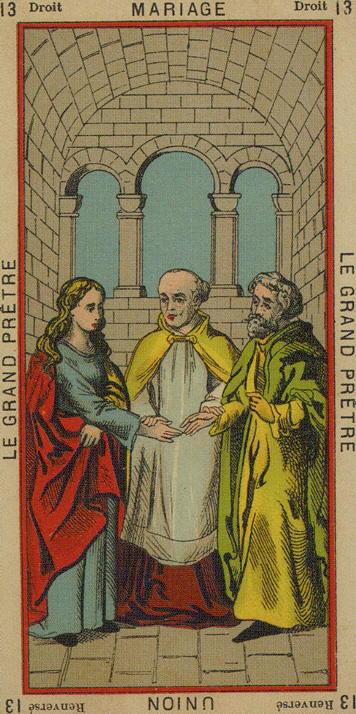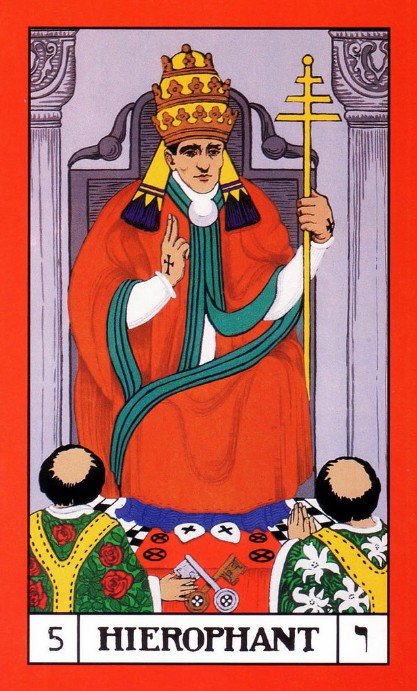Rider-Waite
He wears the triple crown and is seated between two pillars, but they are not those of the Temple which is guarded by the High Priestess. In his left hand he holds a sceptre terminating in the triple cross, and with his right hand he gives the well-known ecclesiastical sign which is called that of esotericism, distinguishing between the manifest and concealed part of doctrine. It is noticeable in this connexion that the High Priestess makes no sign. At his feet are the crossed keys, and two priestly ministers in albs kneel before him. He has been usually called the Pope, which is a particular application of the more general office that he symbolizes. He is the ruling power of external religion, as the High Priestess is the prevailing genius of the esoteric, withdrawn power. The proper meanings of this card have suffered woeful admixture from nearly all hands. Grand Orient says truly that the Hierophant is the power of the keys, exoteric orthodox doctrine, and the outer side of the life which leads to the doctrine; but he is certainly not the prince of occult doctrine, as another commentator has suggested.
He is rather the summa totius theologiæ, when it has passed into the utmost rigidity of expression; but he symbolizes also all things that are righteous and sacred on the manifest side. As such, he is the channel of grace belonging to the world of institution as distinct from that of Nature, and he is the leader of salvation for the human race at large. He is the order and the head of the recognized hierarchy, which is the reflection of another and greater hierarchic order; but it may so happen that the pontiff forgets the significance of this his symbolic state and acts as if he contained within his proper measures all that his sign signifies or his symbol seeks to shew forth. He is not, as it has been thought, philosophy-except on the theological side; he is not inspiration; and he is not religion, although he is a mode of its expression.
A.E. Waite
Meanings
Marriage, alliance, captivity, servitude; by another account, mercy and goodness; inspiration; the man to whom the Querent has recourse.
Reversed meanings
Society, good understanding, concord, over-kindness, weakness.
Etteilla
Marriage

Union, Joining, Assembling, Bond, Alliance, Chain, Slavery, Financial Straits, Captivity, Servitude.
Marriage reversed meanings
Society, Contacts, Alloy, Blending, Compounding. Peace, Concord, Accord, Harmony, Correct Understanding.
Thierens
V. The Hierophant. Leo.
The sanctifying of the profane (man) by the holy (man) in general, and this fact gave the reason for the other nomination of this card: the pope. Of course it may equally well be called the patriarch. In the masonic lodge it is the R.W.M., the sun in the solar system and the heart in every living body, as also the solar plexus in the etheric body. And as the teaching of St. Paul — and others — has it: from the heart are the issues into life. It is the dynamic centre of every living existence.
Paul Foster Case
5. Le Pape

This card corresponds to the letter Vau, and to the sign Taurus, the attribution being that given in the Book of Formation. In this connection it may {be} of interest to note that the name of the first Pope was Simon, or Simeon, which in Hebrew is “hearing.” Hearing is also attributed to the letter Vau in Qabalah, and Taurus, according to astrology, rules the neck, throat and ears, so that this sign is directly connected with those parts of the human body which establish communication by means of speech. “LE PAPE” means literally “The Father,” and in the technical language of the Qabalah the name “Father” is particularly associated with the idea of Wisdom.
Le Pape meanings
Thus the divinatory meanings of this Key correspond to these fundamental notions: Divine Wisdom; intuition; explanation, teaching. It is also a symbol of occult force voluntarily invoked. Of this the symbol of the pentagram is a reminder.
Ouspensky:
VII – THE HIEROPHANT
Mysticism. Theosophy. Esoteric side of all religions.

0 Comments